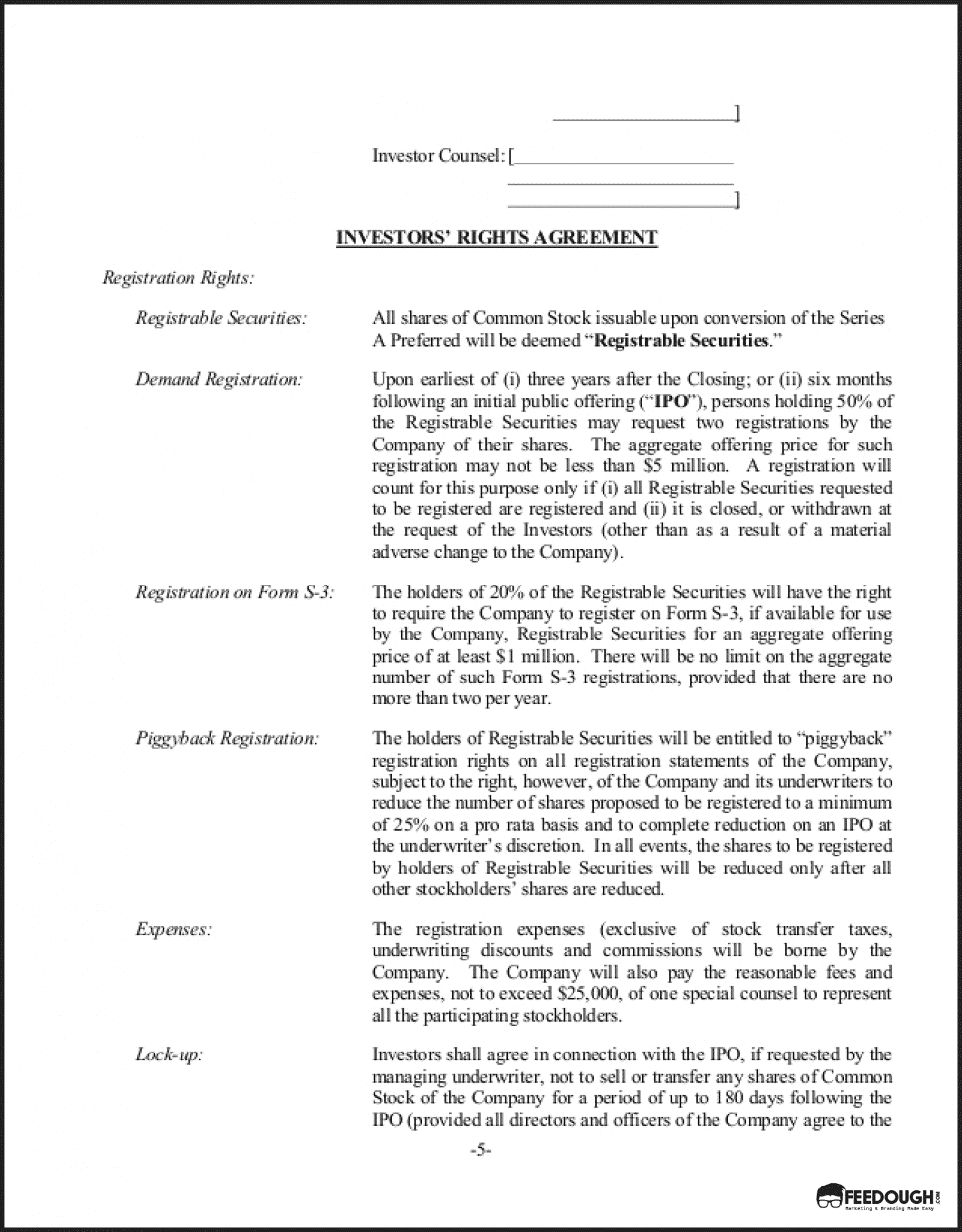If you’re starting a new business or startup, you know that raising capital can be a complex and time-consuming process. However, you can make the process easier and more efficient with the right knowledge and tools. And the first thing you need to know is a Term Sheet.
A term sheet is an important document that provides the framework of a potential business agreement between two parties. It is most useful during a business transaction’s negotiation phase, such as a merger, acquisition, or investment.
It acts as a preliminary agreement between the parties. It lays down the basic terms and conditions of the agreement, such as the type of transaction, the purchase price, the payment terms, the closing date, and the conditions that must be met before the transaction can be completed.
This article will outline the key elements of a Term Sheet, give insights for negotiating and drafting an effective Term Sheet, and arm you with the knowledge of all the key clauses that should be included in a term sheet.
What Is A Term Sheet?
A term sheet is a non-binding document that outlines the key terms and conditions of a proposed investment or business deal.
This document is typically used in the early stages of negotiations between parties, such as investors and startups or between companies involved in mergers and acquisitions.
For startups, term sheets are critical as they lay the groundwork for future business deals with investors. It usually forms the basis for the Shareholders’ Agreement which every shareholder signs in the future.
Consider it a preliminary agreement that helps limit risks and establishes a foundation for future conversations. It is necessary to verify that both parties are on the same page before proceeding with a more formal and legally enforceable agreement.
It is essential to understand that a term sheet is not a legally enforceable agreement. Instead, it acts as a non-binding agreement outlining the principal elements of the transaction, such as the purchase price, payment terms, closing date, and criteria that must be satisfied before finalising the transaction.
Finally, a term sheet is a method for the business and investors to develop trust and build a solid partnership. It guarantees that both parties are committed to obtaining a mutually advantageous agreement by providing clear knowledge of the necessary conditions and expectations of the contract.
Why Is A Term Sheet Important?
The term sheet is an important document that outlines the significant terms and conditions without getting into the nitty-gritty details. While it is not a legally binding document, it serves as a preliminary agreement that allows parties to negotiate and agree on the key aspects of a deal. Here are some reasons why a term sheet is important:
- Clarifies the parties’ intentions: A term sheet helps parties to have a clear understanding of each other’s intentions regarding the terms and conditions of the agreement. It outlines the deal’s key points and specifies what each party wants and expects from the other.
- Builds trust: Even though a term sheet is not legally binding, it still provides both parties clarity and comfort. It helps them understand and agree on the terms negotiated and builds trust in the relationship.
- Enables negotiations: A term sheet provides a framework for parties to state their terms and conditions and negotiate them to reach an agreement. It helps the parties to state their expectations and requirements and fosters productive negotiations.
- Saves time: A term sheet only specifies the significant clauses of a deal and hence takes less time to complete than a detailed legal agreement.
- Reduces the risk of future conflicts: A term sheet can reduce the chances of misunderstandings or misconceptions and minimise any unnecessary disputes that may arise during the deal’s execution.
- Cost-effective: A term sheet can also help to avoid expensive legal charges when making a legally binding agreement. As the parties have already decided and agreed upon all the terms and conditions, it can save on legal fees.
The term sheet can help parties negotiate and agree on a deal’s practical terms and conditions. It can provide clarity, build trust, and help avoid future conflicts, making it an essential tool for businesses and investors.
What Are The Provisions Of The Term Sheet?
The term sheet is usually divided into two sections: economic terms and control terms.
The possible return investors and other shareholders may obtain during a liquidity event, such as a sale, wind-down, or IPO, is described in economic terms.
Control terms, on the other hand, describe the processes that provide investors and other shareholders influence over the corporation or allow them to veto specific choices made by the company. These two sections are the most important parts of a term sheet and are critical in making investment decisions.
Economic Terms
A term sheet’s economic terms are the financial provisions that dictate the conditions of an investment or purchase. These parameters can have a considerable influence on the deal’s success. Thus they must be carefully considered during the negotiating process.
Ultimately, the economic provisions of a term sheet are essential to a deal’s success. It is critical to thoroughly evaluate and negotiate each provision to ensure all parties are happy with the final agreement.
Let us take a look at all the important Economic terms a term sheet should have;
Price
The pricing term in a term sheet refers to the agreed-upon price at which investors will pay for their participation in the firm. This price may be determined by a number of criteria, including the company’s value, the amount of money necessary, and the percentage of stock sold to investors. The pricing term is an essential component of the term sheet because it defines how much cash the firm will get and what percentage of ownership the investors will have in the company.
Let’s say a startup company is looking to raise $5 million in funding from investors in exchange for 20% equity in the business. In this scenario, the price term of the term sheet would specify that the investors would pay $5 million for a 20% stake in the company, resulting in a pre-money valuation of $20 million ($5 million divided by 20%).
Further information, such as the mode of payment (e.g., cash or stock) and any relevant discounts or premiums, may be included in the price term. The agreed-upon pricing term will influence the amount of money the business receives and the ownership percentage held by the investors in the firm.
While the price per share represents the real cost ownership, investors may refer to it as “value.” Investors might look at two valuations: pre-money and post-money. Pre-money valuation refers to the projected value, whereas post-money valuation includes the pre-money valuation and the final investment amount. Understanding these distinctions allows for a better assessment of the firm’s true worth and makes educated judgements when negotiating investment terms.
Liquidation Preference
Liquidation preference is the procedure in which investors are paid out during a liquidation event, such as the company’s sale or winding down. This clause is crucial because it defines the payment hierarchy, which can substantially influence investors’ returns.
The liquidity preference is usually expressed as a multiple of the initial investment amount. A 1x liquidation preference, for example, indicates that investors must get at least the amount of their original investment before any subsequent distributions can be issued. Instead, the term sheet may include a 2x liquidation preference, which indicates that before any future distributions are given, investors must get twice the value of their initial investment.
Let’s assume a startup business gets $10 million in venture capital; the term sheet contains a 1.5x liquidation preference. If the firm is later sold for $15 million, the investors are entitled to $15 million minus ($10 million x 1.5), or $0, because the liquidation preference payout exceeds the sale price. If the firm is sold for $30 million, the investors will receive $15 million, which is equal to their initial investment plus the 1.5x liquidation preference. Any residual proceeds would then be divided among the remaining shareholders in proportion to their ownership percentage.
Pay-To-Play
Pay-to-play is a condition in a term sheet that compels investors to continue investing in the firm to retain their rights and privileges as investors. From the company’s standpoint, this clause can assist in maintaining continuous investor support and prevent the dilution of current shareholders’ ownership interests.
Often, the pay-to-play condition is structured as a requirement for investors to maintain a particular percentage of ownership in the firm by contributing further cash in succeeding rounds. A term sheet, for example, may include a condition requiring investors to put an extra 50% of their initial investment in the company’s next fundraising round to retain their ownership percentage.
Assume a startup firm gets $10 million in capital from investors, with one of the investors owning 10% of the company. If the term sheet has a pay-to-play condition requiring investors to preserve their ownership percentage by investing further cash, that investor would be forced to contribute $500,000 (10% of the following fundraising round, which is $5 million) to retain their ownership interest.
From the company’s perspective, the pay-to-play provision can assist in securing continuous support and investment from investors, which can be necessary for long-term success. But, the conditions of the pay-to-play option must be carefully considered to ensure that they are fair and equitable for all parties involved.
Vesting
Vesting is a term sheet clause specifying the timetable and conditions under which an investor’s or employee’s ownership share in the firm becomes fully “vested” or earned. From the firm’s standpoint, this clause can guarantee that investors and workers are dedicated to the company’s long-term success and are encouraged to stay with the company for a lengthy period.
The vesting provision is often stated in a schedule that specifies the timetable and conditions under which an investor’s or employee’s ownership share becomes completely vested. A term sheet, for example, may include a clause outlining a four-year vesting plan for employee stock options, with 25% vesting after one year and the remaining options vesting in equal monthly amounts over the next three years.
From the company’s standpoint, the vesting provision can assist in guaranteeing that workers and investors are dedicated to the company’s long-term success. The corporation can motivate investors and workers to stay with the company for a lengthy period of time and work towards its long-term goals by demanding a particular amount of time and/or performance before an ownership interest becomes completely vested.
However, it is critical to carefully evaluate the vesting provision’s wording to ensure they are fair and reasonable for all parties concerned. For example, if an employee is let go before their ownership share has fully vested, they may lose a sizable percentage of their prospective remuneration. As a result, it’s critical to strike a balance between the requirement for long-term commitment and the need for fair and equitable conditions for all parties involved.
Exercise Period
The exercise period is a clause in a term sheet that describes the timetable and conditions under which an investor or employee can exercise their options to buy shares in the firm. From the company’s standpoint, this clause guarantees that the company understands when and how the stock will be distributed and can prepare appropriately.
The exercise period provision is usually expressed as a timeline that specifies the time frame an investor or employee can exercise their options. A term sheet, for example, may include a condition granting an investor the opportunity to acquire ownership in the firm within a certain time frame, such as 90 days following the company’s first public offering (IPO).
The exercise period provision might assist the firm in guaranteeing that equity is granted in a timely and effective way. The firm may plan adequately and ensure sufficient cash to satisfy its business goals by establishing defined timetables for when stock can be bought.
However, the conditions of the exercise period provision must be carefully considered to ensure that they are fair and reasonable for all parties concerned. Investors or workers, for example, may need more time to decide whether or not to exercise their options if the exercise period is too short. As a result, it’s critical to strike a balance between the need for defined timetables and the need for fair and acceptable conditions for all parties concerned.
Employee Pool
The employee pool provision is an essential feature in a term sheet that sets aside a specified amount of stock for the company’s employees. According to the corporation, this option can help recruit and retain top talent by giving employees a share in the company’s success.
The employee pool provision is often specified as a percentage of the firm’s stock or a predetermined number of shares. A term sheet, for example, may include a clause reserving 10% of the company’s total stock for workers.
The employee pool provision, from the employer’s perspective, can assist in ensuring that the company has competent and engaged personnel. By giving employees a stake in the company’s success, the firm may connect their interests with the company’s and guarantee that they are motivated to work towards its goals.
However, the conditions of the employee pool provision must be carefully considered to ensure that they are fair and reasonable for all parties concerned. For example, if the company’s personnel pool is too limited, it may be able to recruit or retain top talent. As a result, it’s critical to strike a balance between the requirement for a competitive equity pool and the need to preserve the company’s interests.
Overall, the employee pool clause is a significant term sheet feature since it may assist in recruiting and retaining top personnel while aligning employees’ interests with the firm’s.
Antidilution
Antidilution is a term sheet provision that protects current investors from dilution of their ownership in the firm. Dilution happens when a corporation issues additional shares of stock, which can reduce current shareholders’ percentage ownership. Antidilution provisions try to prevent this from happening or safeguard current shareholders if it occurs.
Antidilution provisions are classified into two types: full ratchet and weighted average. Complete ratchet is the most aggressive option, as it adjusts the preferred share conversion price to the lowest price in the following round. This implies that if the firm issues new shares at a lower price than existing investors, their conversion price will be changed to reflect the lower price, safeguarding their ownership percentage.
A weighted average is a less harsh and more prevalent antidilution measure. It modifies the conversion price depending on the weighted average price of new shares issued in the next round, considering both the price and the number of new shares issued. This technique protects existing owners while allowing new investors to join in later rounds at cheaper valuations.
Antidilution provisions are often expressed as a clause in the section on the rights and preferences of preferred stock in a term sheet.
Here’s an example of how this clause can be written is:
“The preferred stock will have an antidilution clause that protects investors’ ownership percentage in the event of future equity issuances at a lower valuation. The antidilution provision will be calculated using a weighted average calculation considering the price and quantity of shares issued in future financing rounds.”
This clause assures that if the firm issues new shares at a lower price than the investors paid, the investors’ shares will be modified to reflect the lower price as well. This prevents investors from having their ownership stake in the firm diluted. Without an antidilution clause, the corporation might issue new shares at a lower price, lowering the value of existing shares, which would be unjust to investors.
Control Terms
Control terms in a term sheet refer to the set of provisions that allow the investors and the startup to exercise control over the terms and conditions of the agreement. The control terms provided in a term sheet must be considered carefully. While it may be essential to concede some control to the investor to acquire money, ensuring that the investor’s objectives correspond with the firm’s and that the company has sufficient control to carry out its strategic vision is critical.
Control terms should be defined clearly and concisely, outlining the exact areas over which the investor would have control and the limitations of that power. While creating control terms, it is critical to engage with legal counsel to ensure that they are enforceable and in accordance with existing laws and regulations.
Some of the important Control terms a term sheet should have are:
Board Of Directors
The board of directors is an essential provision that should be included in every term sheet. It describes the company’s board of directors’ composition, responsibilities, and powers. The board of directors is in charge of steering the company’s overarching strategy and overseeing the management team.
The board of directors clause in the term sheet describes the number of board seats, who will occupy them, and how they will be chosen. The clause should also specify the board members’ terms of service, such as the duration of their term and the method for re-election.
The board of directors clause may also include specifics on how the board will make decisions, such as the quorum necessary for meetings and board members’ voting rights. Furthermore, the clause may specify the board’s obligations, such as approving the company’s budget, important strategic objectives, and mergers or acquisitions.
A term sheet, for example, may include a clause stating that the board of directors would be composed of five members, two of whom will be nominated by the investors and three by the company’s founders. The rule may also say that decisions will be taken by majority vote and that a quorum must consist of at least four board members. Furthermore, the clause may provide that the board of directors meet quarterly to examine financial performance and strategic goals.
Overall, the board of directors provision is essential to any term sheet since it establishes the framework for the company’s governance structure framework and helps ensure all parties are united on major strategic choices.
Protective Provisions
Protection provisions are terms in a term sheet that provide investors with specific rights and safeguards to ensure the safety of their investment. These clauses provide investors veto power over certain choices or force the corporation to seek approval before taking certain actions.
Protective clauses are intended to safeguard the investor’s interests by prohibiting the corporation from doing acts that might jeopardise the investment. As a business, it is critical to understand these requirements and ensure that they are constructed fairly and appropriately.
This clause might be written in a term sheet in the following way:
“The firm agrees to get the investor’s agreement before issuing further shares or securing future finance. The investor will be entitled to obtain all financial accounts, business plans, and other important information needed to make educated investment decisions. Any action that considerably and negatively damages the investor’s investment shall be subject to veto.”
Drag-Along Agreement
A drag-along agreement is a term sheet feature that helps ensure a smooth and efficient firm sale or merger. This clause permits the majority shareholders to compel minority shareholders to sell their shares alongside the majority shareholders to a possible acquirer or merger partner.
The drag-along provision is often incorporated to avoid circumstances in which a minority shareholder attempts to obstruct a sale or merger that would benefit the firm as a whole. The firm can get a better valuation and terms by forcing all shareholders to participate in the deal.
The drag-along clause is typically written so that it can be triggered by the majority shareholders when a particular proportion of shares consent to the sale or merger. The clause, including a minimum sale price or a specific degree of board approval, may also protect minority shareholders.
Assume that Business A is considering selling itself to Company B. Shareholder X holds 60% of the shares in Company A, Shareholder Y owns 30%, and Shareholder Z owns 10%. If the term sheet includes the drag-along provision, Shareholder X can force Shareholders Y and Z to sell their shares to Company B, even if they don’t want to. This guarantees that the sale goes smoothly and that Company A receives the best possible price.
It is crucial to remember that drag-along agreements can have severe ramifications for minority owners. Thus these clauses must be properly negotiated with the help of legal and financial specialists. The agreement’s contents should be carefully studied to ensure that minority owners are treated properly and that their interests are safeguarded.
Conversion
Conversion is a term sheet clause that defines the terms and conditions under which the investor’s preferred shares can be converted into common shares. This clause is crucial for protecting the company’s interests while assuring the investor of n acceptable return on investment.
The conversion provision is often expressed as a formula that describes the conversion rate and the conditions under which the conversion can occur. The conversion rate is normally a predetermined ratio that defines the number of common shares converted from preferred shares.
For example, if the investor possesses $10 million in preferred shares and the conversion ratio is 1:1. If the firm decides to go public, the investor can change their preferred stock into common stock and become a shareholder.
The conversion clause is critical from the company’s standpoint since it can drastically change its ownership structure. The corporation can guarantee that the investor’s preferred shares do not dilute the holding of the common shareholders by determining the conversion ratio and terms of conversion.
Furthermore, by allowing investors the opportunity to convert their shares into common shares in the case of a change in management, the conversion clause helps shield the firm from potential hostile takeovers.
Overall, the conversion clause is a vital component of a term sheet that must be carefully crafted to safeguard both the investor’s and the company’s interests.
Other Terms Of The Term Sheet
It is essential to include a number of significant clauses in addition to the ones we have covered thus far when drafting a term sheet. These clauses can substantially influence the terms of a proposed investment, and both the firm and the investors should carefully analyse them.
Therefore, some of the other important provisions of a term sheet are:
Dividends
A dividend clause is a provision in a term sheet that describes the terms and circumstances for paying dividends to investors. Dividends are a method for businesses to disperse earnings to shareholders, and they are often paid out in cash or extra shares of stock. A dividend clause in a term sheet is essential because it establishes expectations for investors and clarifies how dividends will be paid out.
While drafting a dividend clause, it is essential to consider variables such as dividend payment schedule, frequency, dividend rate, and any special circumstances that may apply. A firm, for example, may opt to pay dividends annually, quarterly, or on an as-needed basis. The dividend rate might be set or dependent on a proportion of profits or earnings.
A dividend clause is a method for the company to motivate and reward investors for their investments. A dividend clause can help a firm acquire the capital it needs to develop and expand by making an investment opportunity more appealing to potential investors.
For example, “A Company will pay an annual dividend to preferred stockholders equivalent to [X]% of the preferred stock’s initial issue price. Dividends will be paid on [insert date] of each year starting with [enter year]. If the business does not have enough earnings to pay the whole dividend, the unpaid amount will be accumulated and paid later when profits become available.”
It is vital to remember that the particular parameters of a dividend clause will be determined by the company’s unique circumstances and the investment opportunity. As a result, while creating a dividend clause, it is critical to engage with legal and financial specialists to ensure that it appropriately reflects the interests and goals of the firm and its investors.
Redemption Rights
While drafting a term sheet, it is essential to consider redemption rights. They give investors the right to request that a corporation repurchase their shares after a certain time or event, such as an IPO or a change in the company’s ownership.
It is critical for the firm to carefully analyse the terms of any redemption rights clause to ensure that they correspond with the company’s strategic goals and financial status. A redemption right that permits investors to demand that their shares be repurchased at an unreasonably low price may severely impact the company’s finances.
When drafting a redemption rights clause, clarifying the conditions under which investors can demand the repurchase of their shares and the timetable and terms of such buyback is critical. It is also critical to analyse any potential conflicts with other provisions, such as antidilution or protective clauses, and to ensure that the redemption rights provision is compatible with the firm’s overall business plan.
A redemption rights provision, for example, can indicate that investors have the right to demand the repurchase of their shares at the original purchase price plus interest after five years or if the company’s control changes. The clause may also limit the number of shares that can be repurchased at one time, or it may require the firm to have adequate cash to repurchase the shares without negatively impacting its financial condition.
Ultimately, a well-drafted redemption rights provision can offer investors some security while promoting the company’s long-term aims.
Conditions Precedent To Financing
Conditions precedent to financing is essential criteria that must be accomplished before financing may be finalised. They are intended to safeguard the investment by requiring that certain conditions be met before the money is given.
It could be listed in a term sheet as things like receiving appropriate regulatory permissions, signing a definitive agreement, or securing particular licences. These terms may differ based on the sort of funding requested, but they are often included to safeguard the investor from any potential hazards.
It is essential to ensure that the precedent conditions are feasible and acceptable and that they should not burden the organisation unnecessarily. It is also critical to ensure the criteria are detailed and unambiguous so that all parties understand what is expected.
A term sheet could include the following conditions precedent to financing:
- The purchase requires the firm to receive the necessary regulatory approvals.
- The firm and the investor must execute a binding agreement stating the terms and circumstances of the financing.
- The corporation must receive the relevant permits to conduct business.
- The investor must be satisfied with the company’s due diligence outcomes.
- The firm must provide any information the investor requires concerning the financing.
- The funding will be terminated if these requirements are not satisfied.”
The firm and the investor need to include the precedent of financing conditions in a term sheet to guarantee that the financing runs smoothly and without unanticipated stumbling blocks.
Information Rights
A term sheet must include an information rights section that describes the investor’s right to access and receive financial and other pertinent information about the firm. These rights are critical for investors because they enable them to make educated investment decisions. There are two types of information rights: periodic reporting and on-demand reporting.
Periodic reporting is the regular release of financial and other information to investors, such as quarterly or yearly reports. On-demand reporting refers to the transmission of information requested by investors at the time they need it.
It is important to explicitly explain the sort of information that will be delivered, how frequently it will be provided, and to whom it will be provided when putting this provision in a term sheet. The clause may, for example, require the corporation to produce quarterly financial statements, annual audited financial accounts, and monthly cash flow statements. It may also specify that the information will be available to all existing investors and any possible new investors.
The company can create clear expectations for its investors and foster openness and confidence in the relationship by clearly outlining the type, frequency, and recipients of the information to be provided.
Registration Rights
Registration rights are important to include in a term sheet since they govern investors’ capacity to register and sell their shares in a firm. These rights are often offered to investors who acquire private corporation equity securities to trade on public markets.
It generally specifies the circumstances under which an investor may demand a corporation to register its securities with the Securities and Exchange Commission (SEC). This clause may specify the number of shares that can be registered, the date of the registration, and the company’s duties related to the registration procedure.
The Registration Rights clause, from a company’s perspective, can be crucial in recruiting and maintaining investors since it allows investors to sell their shares on a public market. Nonetheless, the firm must guarantee that the registration procedure does not negatively impact the company’s activities or other investors.
This clause describes the investor’s right to seek registration of their shares and the company’s obligation to comply with such demand, including the timing and cost of the registration procedure. To guarantee that the Registration Rights clause is fair and reasonable for all parties concerned, both parties must discuss and agree on its provisions.
Right of First Refusal
The Right of First Refusal (ROFR) is a term sheet provision that allows a company to buy shares from a shareholder before selling such assets to a third party. This provision gives the business the first chance to purchase any shares offered for sale, ensuring that the corporation retains some control over who owns its shares.
The ROFR provision specifies the circumstances under which the right may be exercised, the requisite notification time, and the method for exercising the right. The term sheet will also specify which securities are covered by the ROFR, such as ordinary stock, preferred stock, or options.
The ROFR clause may be a significant safeguard for a firm since it helps ensure that ownership of the firm stays in the hands of a few investors. It can also appeal to potential investors since it gives them a sense of security and control over their money.
Voting Rights
The power to vote in company governance, such as choosing board members or making crucial business decisions, is called voting rights. The voting rights provision in a term sheet specifies who has the right to vote on specific corporate topics and how those votes will be counted.
From the company’s standpoint, ensuring that voting rights are properly specified is critical to avoid confusion or disagreements later on. Voting rights are typically defined by the number of shares each investor holds
For example, if an investor owns 10% of the company’s outstanding shares, they will have 10% of the voting rights on all topics brought to a stockholder vote. If a vote is necessary to elect new board members, and the investor owns 10% of the existing shares, they will have 10% of the votes to choose new board members.
It’s worth noting that certain investors may bargain for extra voting rights, such as the authority to select a particular number of board members or veto certain management decisions. In such circumstances, the voting rights portion of the term sheet should explicitly define these specific requirements.
The voting rights provision is a critical component of any term sheet since it describes how decisions will be made inside the firm and ensures that each investor’s rights are clearly specified.
Restriction On Sales
A Restriction on Sales, commonly known as a lock-up agreement, is a key term sheet clause. This clause describes the restrictions on when and how investors can sell their firm shares.
A sales limitation, from the firm’s perspective, can assist in guaranteeing stability and avoiding significant, rapid changes in ownership that could negatively damage the company. It also provides the corporation with greater control over who becomes a shareholder.
The provision can be written in a variety of ways, but it usually has the following critical elements:
- Duration: This specifies how long the lock-up period will be in force. Depending on the company’s unique needs and circumstances, it might span several months to many years.
- Restrictions: This section describes the restrictions on when and how shares can be sold. It may, for example, limit sales during the lock-up period or mandate that shares be sold exclusively to specific parties.
- Exceptions: This section details any exceptions to the limitations, such as permitting sales in specific circumstances, such as if the investor is in financial difficulty.
- Penalties: This section defines any penalties or repercussions for breaking the limitation of the sales.
Proprietary Information and Invention Agreement
The Proprietary Knowledge and Invention Agreement is a critical item that should be included in any company’s term sheet. This agreement establishes the guidelines for sensitive information and intellectual property generated by the firm and its workers over the course of their work.
The Proprietary Information and Invention Agreement guards against workers, contractors, or partners sharing or stealing sensitive information and intellectual property. It protects the confidentiality of the company’s sensitive information, such as trade secrets, customer lists, and financial information, and that it is not divulged to unauthorised parties.
The agreement also specifies who owns and protects innovations, patents, and other intellectual property employees develop while employed by the corporation. This section often compels workers to reveal any discoveries or patents they create while working for the firm, giving ownership to the corporation.
Co-sale Agreement
A Co-Sale Agreement is a clause that permits investors to sell their shares in a corporation when other shareholders sell theirs. This clause is significant because it protects minority owners’ interests while ensuring all shareholders can participate in a sale.
The Co-Sale Agreement, usually included in a term sheet, specifies the terms and conditions under which minority shareholders can sell their shares. When a major shareholder decides to sell their shares, the agreement is frequently activated, and it allows minority owners the ability to sell their shares on the same conditions as the main shareholder.
This clause assures all shareholders the same chance to sell their shares at the same time and price. It also helps to avoid situations in which a majority shareholder sells their shares at a premium, leaving minority owners unable to participate in the transaction.
In addition to the above, the Co-Sale Agreement may include terms concerning the timing and structure of the sale, such as how the shares will be sold and who will be in charge of the sale.
Founder’s Activities
Founders are essential to every business, and their ongoing commitment and passion are critical to the company’s success. A term sheet’s Founder’s Activities clause is intended to safeguard the firm’s interests if a founder decides to quit the company or participate in specific activities that may damage the company.
The Founder’s Activities provision in a term sheet typically describes the activities the founders are not permitted to engage in during and after their stay at the firm. Non-compete, non-solicitation, and non-disparagement terms may be included in this provision.
This provision protects the firm’s intellectual property and guarantees that the founders do not use their inside knowledge to start a competitor company or poach staff or customers.
It is vital to highlight that the Founder’s Activities section should be carefully drafted to balance the firm’s interests with the founders’ rights and freedom to pursue their professional possibilities. The condition should be manageable because it precludes the founders from earning a living or unjustly limits their alternatives once they leave the firm.
An Initial Public Offering (IPO) occurs when a private firm goes public for the first time by selling shares of its stock to the general public. It is essential for a business planning an IPO to discuss the terms of the IPO with potential investors in the term sheet.
The Initial Public Offering Shares Buy provision, which permits investors to acquire additional shares of the company’s stock at the IPO price, is linked to IPOs. This clause is typically included in a term sheet to encourage investors to participate in the firm by allowing them to acquire shares at a lower price than they would be able to after the IPO.
The following details are frequently written into the Initial Public Offering Shares Purchase provision:
- Number of Shares: The number of shares the investor may acquire at the IPO price.
- Purchase Price: The initial public offering (IPO) price of the shares.
- The deadline for investors to exercise their option to buy shares at the IPO price.
- Allocation: The percentage of the total shares available in the IPO that the investor can acquire.
The period following the IPO during which the investor is not permitted to sell their shares.
Adding the Initial Public Offering Shares Buying provision in your term sheet might assist in attracting potential investors and provide them with an extra incentive to engage in your company’s IPO. It is critical to thoroughly evaluate the provision’s wording and ensure they correspond with the company’s overall aims and objectives.
No Shop Agreement
A No Shop Agreement, also known as an Exclusivity Agreement, is a term sheet condition that prohibits a firm from engaging with other possible investors or acquirers for a set period of time while the existing investor does due diligence.
According to the company, a No Shop Agreement assures the present investor a fair opportunity to complete due diligence and potentially invest in the firm without fear of competition from other possible investors or acquirers.
The No Shop Agreement typically contains a time when the firm is not allowed to talk to other possible investors or acquirers, as well as exceptions to this rule. For example, if a proposal significantly more advantageous than the current offer is received, the firm may be permitted to participate in conversations with other parties.
It is crucial to highlight that a No Shop Agreement should be adequately designed to ensure the company’s flexibility to seek other prospective possibilities is reasonable. The time limit and exclusions should be discussed to allow the firm flexibility while giving the investor a reasonable opportunity to undertake due diligence and participate in the company.
Indemnification
Indemnification is a crucial term sheet provision that protects a firm and its investors against financial losses caused by legal battles or other obligations. In essence, it implies that one party (the indemnitor) undertakes to reimburse the other party (the indemnitee) for any damages, losses, or expenditures suffered due to specific events or acts.
Indemnification is often stated as a distinct section or provision in a term sheet. It can cover a variety of concerns, including breaches of representations and warranties, third-party claims, intellectual property infringement, and regulatory violations.
From the company’s perspective, here’s how indemnification may be worded in a term sheet:
Indemnification: The Company agrees to indemnify, defend, and hold harmless the investor, its officers, directors, agents, and affiliates from and against any and all claims, damages, liabilities, costs, and expenses (including reasonable attorneys’ fees) arising out of or in connection with (a) any breach of the company’s representations and warranties in this term sheet, (b) any third-party claims relating to the Company’s Business or operations, (c) any infringe of third-party intellectual property rights by the company, or (d) any violation of applicable laws or regulations by the company.
This clause guarantees that the corporation is held accountable for any legal or financial implications of its conduct and that the investor is protected from any losses incurred due to those consequences. In essence, it contributes to developing a sense of trust and accountability between the two parties, which is necessary for a successful investment partnership.
Assignment
The parties’ capacity to transfer their rights and duties to a third party is described as an assignment in a term sheet. This is a crucial provision since it might have serious consequences for the firm and its investors.
The assignment provision should be carefully worded from the company’s perspective to guarantee that the company’s interests are protected. Normally, the condition restricts the investor’s capacity to transmit their rights and liabilities to a third party without the firm’s approval. This is significant because it means that the firm controls those it works with and may avoid being burdened with an undesirable or inappropriate partner.
Furthermore, the assignment clause will typically compel any third party to undertake all of the assignor’s rights and duties under the term sheet. This is critical because it assures that the third party is entirely liable for all commitments outlined in the term sheet and that the firm is not exposed to any risks or liabilities.
An assignment provision in a term sheet may look like this:
“Assignment. Each party may assign any of its rights or duties under this term sheet with the other party’s prior written approval. Any effort to assign without such approval is null and invalid. If this term sheet is assigned, the assignee will take all of the assignor’s rights and duties under it.”
Overall, the assignment provision is a critical component of a term sheet that should be carefully researched and constructed to safeguard the company’s interests.
Tips on Drafting a Term Sheet
A term sheet is essential in establishing an agreement with investors or partners. Here are some pointers to remember while drafting a term sheet:
- Be clear and concise: The objective of a term sheet is to offer a brief and clear explanation of the essential aspects of the agreement. It should be simple to grasp for all parties concerned. Avoid employing legal jargon that might confuse the opposing party, and keep the language simple.
- Include just the important terms: A term sheet should only cover the important terms of the transaction. Little details or legal issues that can be handled later in a more complete agreement should not be included. This allows the people concerned to concentrate on the main issues rather than becoming bogged down in little minutiae.
- Be reasonable and fair: A term sheet should be reasonable and equitable to both parties. Avoid employing phrases that are biased to one side or the other. Remember that the aim is to reach a mutually beneficial arrangement that benefits everyone.
- Keep it non-binding: Term sheets are typically non-binding, which means they are not legally enforceable. This permits the parties to keep discussing and changing the conditions without the risk of violating a formal contract. Nonetheless, a declaration outlining which parts are obligatory and which are not is required.
- Seek legal advice: It is usually advisable to obtain legal counsel when preparing a term sheet. An expert solicitor can assist in identifying possible concerns and ensuring that the terms and wording are acceptable and enforceable.
- Be adaptable: A term sheet is intended to serve as a starting point for talks. Be open to recommendations and prepared to make concessions on certain issues. It’s critical to keep in mind that the aim is to establish a mutually beneficial agreement.
Drafting a term sheet can be challenging yet rewarding. A properly drafted term sheet can enable a firm to raise money from investors and achieve its business objectives. It can also assist in avoiding possible problems or misunderstandings that may develop while or after the transaction is completed. By following these tips, a business can write a term sheet that is transparent, fair, and effective in negotiating a successful contract with investors or partners.
A Sample Term-Sheet Template
Bottomline
A term sheet functions as the preliminary step for negotiations between the company and the investor, and it establishes the framework for the two sides’ future partnership. A properly-drafted term sheet should include all the significant elements relevant to the firm and the investor and be thorough and precise enough to clearly understand the proposed investment’s terms.
Finally, a term sheet is a vital instrument that may assist businesses in attracting the finance they require to expand and prosper. Companies may put themselves up for success and develop solid, mutually beneficial relationships with their investors by knowing the main clauses that should be included in a term sheet and working with skilled advisers to negotiate and finish the contract.
Go On, Tell Us What You Think!
Did we miss something? Come on! Tell us what you think about our article on term sheet in the comments section.
A lawyer dealing with corporate laws, a voracious reader and a keen writer. Satyaroop has a broad experience in the legal and startup industries and has worked with more than 15 companies, startups and legal publications on research-oriented projects. In his spare time, he enjoys reading fiction, biking and playing video games.










